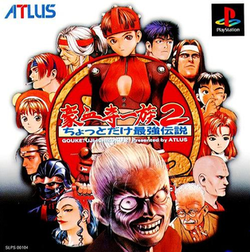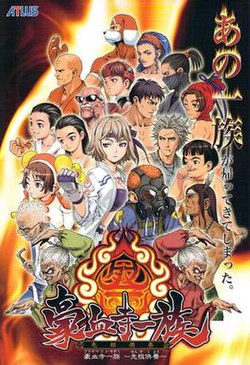Power Instinct
| Power Instinct | |
|---|---|

Logo utilized in the first Power Instinct.
|
|
| Genres | Fighting game |
| Developers |
Atlus Noise Factory |
| Publishers | Atlus |
| Platforms | Arcade, PlayStation, PlayStation 2, Super NES, Genesis, Sega Saturn, Neo Geo |
| First release |
Power Instinct/Gouketsuji Ichizoku November 1993 |
| Latest release |
Gōketsuji Ichizoku Matsuri Senzo Kuyou August 2009 |
| Power Instinct | |
|---|---|
 |
|
| Developer(s) | Atlus |
| Publisher(s) | Atlus |
| Distributor(s) | Excite |
| Designer(s) | Noise Factory, Atlus |
| Platform(s) | Arcade, Super NES, Genesis |
| Release date(s) | November 1993 |
| Genre(s) | Fighting game |
| Mode(s) | Up to 2 players simultaneously |
| Cabinet | Upright |
| Display | Horizontally oriented, 320 × 224, 2048 palette colors |
| Power Instinct 2 | |
|---|---|
 |
|
| Developer(s) | Atlus |
| Publisher(s) | Atlus |
| Distributor(s) | Excite |
| Designer(s) | Super-K!, Markey, Helen |
| Platform(s) | Arcade, PlayStation |
| Release date(s) | April 1994 |
| Genre(s) | Fighting game |
| Mode(s) | Up to 2 players simultaneously |
| Cabinet | Upright |
| Arcade system | CAVE 1st generation |
| Display | Horizontally oriented, 320 × 240, 10240 palette colors |
| Gogetsuji Legends | |
|---|---|
 |
|
| Developer(s) | Atlus |
| Publisher(s) | Atlus |
| Distributor(s) | Excite |
| Designer(s) | Noise Factory, Atlus |
| Platform(s) | Arcade |
| Release date(s) | 1995 |
| Genre(s) | Fighting game |
| Mode(s) | Up to 2 players simultaneously |
| Cabinet | Upright |
| Arcade system | CAVE 1st generation |
| Display | Horizontally oriented, 320 × 240, 10240 palette colors |
| Groove on Fight | |
|---|---|
 |
|
| Developer(s) | Atlus |
| Publisher(s) | Atlus |
| Distributor(s) | Excite |
| Designer(s) | Noise Factory, Atlus |
| Platform(s) | Arcade, Sega Saturn |
| Release date(s) | April 1997 |
| Genre(s) | Fighting game |
| Mode(s) | Up to 2 players simultaneously |
| Cabinet | Upright |
| Arcade system | Sega Titan Video |
| Display | Horizontally oriented, 704 × 513, 6144 palette colors |
| Matrimelee | |
|---|---|
 |
|
| Developer(s) | Noise Factory |
| Publisher(s) |
Atlus Playmore |
| Distributor(s) | Excite |
| Director(s) | Keiko Ijuu |
| Producer(s) | Keiko Ijuu |
| Designer(s) | Noise Factory, Atlus |
| Programmer(s) | Hidenari Mamoto, Kazuaki Ezato, H. Hishikawa |
| Composer(s) | Toshikazu Tanaka |
| Platform(s) | Arcade, Neo Geo |
| Release date(s) | May 29, 2003 |
| Genre(s) | Fighting game |
| Mode(s) | Up to 2 players simultaneously |
| Cabinet | Upright |
| Arcade system | Neo Geo (646 Mbit cartridge) |
| Display | Horizontally oriented, 320 × 224, 4096 palette colors |
| Shin Gouketsuji Ichizoku: Bonnou Kaihou | |
|---|---|
 |
|
| Developer(s) | Noise Factory |
| Publisher(s) | Excite |
| Distributor(s) | Excite |
| Platform(s) | PlayStation 2 |
| Release date(s) | May 25, 2006 |
| Genre(s) | Fighting game |
| Mode(s) | Up to 2 players simultaneously |
| Gouketsuji Ichizoku Matsuri Senzo Kuyou | |
|---|---|
 |
|
| Developer(s) | Noise Factory |
| Publisher(s) | Atlus |
| Distributor(s) | Excite |
| Designer(s) | Noise Factory, Atlus |
| Platform(s) | Arcade |
| Release date(s) |
August 2009 (Taito Type X) |
| Genre(s) | Fighting game |
| Mode(s) | Up to 2 players simultaneously |
| Cabinet | Upright |
| Arcade system | Taito Type X, Taito NESiCAxLive |
Power Instinct (豪血寺一族 Gōketsuji Ichizoku?, "The Gōketsuji Clan") is a fighting video game series created by Atlus started in 1993. It is often abbreviated as PI or GI for short.
One of the innovations unique to the series was the introduction of the transformation feature. Several of the characters can change their appearance and fighting style by simply executing certain moves (usually a throwing move), though this has not been featured in every entry in the series. Other features include the ability to perform a double jump and attacking while dashing.
The first game of the series was released in 1993. In it, players play as a member of the Goketsuji clan, who are battling to determine who will replace 78-year-old Oume Goketsuji as head of the clan. It has eight selectable characters and one unplayable boss character, Oume Goketsuji, a palette-swap of her younger sister Otane. Originally, every character had a specific win quote for each defeated foe, but that was reduced to only one win quote for each character in the English version.
This game was ported to Super NES and Genesis and includes some new play modes: Vs. Battle, Practice Mode, Time Attack and a "Life Attack" that consists of defeating as many opponents as possible with just one life bar (similar to the Survival Modes seen in other fighting games).
The Mega Drive version has a Battle Royal mode where 1 or 2 players can select a team, with an option to hide the characters being chosen so they are not revealed until the fight. Additionally, it features an option that allows the strength of each special attack of every playable character to be adjusted to the player's liking.
The English console ports of this game had several omitted features, such as Karaoke Mode with the lyrics for the songs "Tatanka no Uta" and "Otoko no Karatemichi", character biographies that pop up in between demos, the intro demo to the game and the scene of Oume where she speaks to the player before she fights them (which changes if she's fighting Otane). The Super NES version also replaces the endings that were in the Japanese Super Famicom version with a congratulations screen with the character portraits used in the pre-fight screen.
...
Wikipedia
